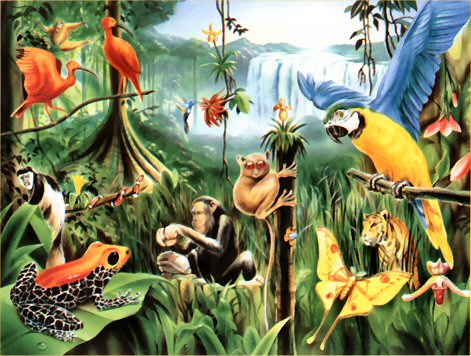Rainforests are the Earth's oldest living ecosystems.
They are so amazing and beautiful.
These incredible places cover only 6 %of the Earth's surface but yet they contain MORE THAN 1/2 of the world's plant and animal species!
A Rainforest can be described as a tall, dense jungle. The reason it is called a "rain" forest is because of the high amount of rainfall it gets per year. The climate of a rain forest is very hot and humid so the animals and plants that exist there must learn to adapt to this climate.
As many as 30 million species of plants and animals live in tropical rainforests.
Beauty of rainforest
Why are rainforest important?
THEY PROVIDE A HABITAT FOR PLANTS AND ANIMALS
Tropical rainforests took between 60 and 100 million years to evolve and are believed to be the oldest and most complex land-based ecosystem on earth, containing over 30 million species of plants and animals. That's half of the Earth's wildlife and at least two-thirds of its plant species!
Because most tropical rainforest grows in warm and steamy environments, it contains a huge variety of plants. One hectare of lowland rainforest may contain 1000 trees with up to 300 species. Compare this to the UK's forests which are likely to have only 5-10 species per hectare: that's 30 to 60 times more species in a hectare of rainforest! These plants in turn provide food and shelter for many rare animals that depend on the rainforest for their survival. There are many more thousands of rainforest plants and animals species still waiting to be discovered.
THEY REGULATE OUR CLIMATE
Rainforests store water like a huge sponge. In fact, it is believed that the Amazonian forests alone store over half of the Earth's rainwater! Rainforest trees draw water from the forest floor and release it back in to the atmosphere in the form of swirling mists and clouds.
Without rainforests continually recycling huge quantities of water, feeding the rivers, lakes and irrigation systems, droughts would become more common, potentially leading to widespread famine and disease.
Did you know that we also depend on trees to cleanse our atmosphere? They absorb the carbon dioxide that we exhale, and provide the oxygen we need to breathe. When rainforest trees are burnt they release carbon dioxide, which pollutes the atmosphere and contributes to global warming. Deforestation is in fact considered the second major driver of climate change (more than the entire global transport sector), responsible for 18-25% of global annual carbon dioxide emissions.
THEY HELP TO PREVENT SOIL EROSION
Surprisingly, soil in the rainforest is very poor in nutrients. This is because the nutrients are stored in the vast numbers of trees and plants rather than in the soil. Tree roots bind the soil together, while the canopy protects the soil from heavy rains. When a tree dies and its trunk falls to the forest floor, it decays and the nutrients it contains are recycled. However, if trees are removed from the forest, the nutrients are removed with it, along with the protection provided by the tree roots and the forest canopy. The unprotected soil is then simply washed away in heavy rains, causing blockages and floods in lowland rivers, while leaving upland rivers dry.
THEY PROVIDE A HOME FOR INDIGENOUS PEOPLE
Many indigenous people have been living in harmony with the rainforest for thousands of years, depending on it for their food, shelter and medicines. When oil and logging companies come to remove vast areas of forest, they bring diseases which the indigenous people have no resistance to, threatening their survival. Often they are also forced to move away from their homes to unfamiliar places, sometimes even being killed in the process.
RAINFOREST PHARMACY
It may surprise you to know that more than 25% of our modern medicines originate from tropical forest plants. Even so, we have only learned how to use 1% of these amazing plants, so imagine the possibilities if we could experiment with the other 99%!
For example, the rosy periwinkle, found in Madagascar, is used to cure leukemia, while the anti-malarial drug quinine is taken from the bark of the Andean cinchona tree. The rauvolfa shrub found in Asian and African forests is used to cure high blood pressure and mental illness. Rainforests and the native populations who discovered these medicines could hold the cure to many more diseases if we would only nurture the forests and allow their people to show us.
OTHER IMPORTANT FOREST PRODUCTS
Many foods we consume today such as nuts, bananas, coffee and spices, and industrial products such as rubber, resins and fibres, were originally found in tropical rainforests.
.jpg)



Enjoy a Egypt In December with its warm sun and cold breeze. Spend a unique warm Christmas with your family in the presence of Egypt's pharaohs on a historic Nile Cruise from Luxor to Aswan and Cairo, the Capital.
ReplyDeleteEvery country in the Middle East has its own unique identity and culture; you can merge between more than one country from the Middle East all in one trip. Merge historical Egypt with modern Dubai or the spectacular Jordan; you have more than one option, to MERGE EGYPT AND MIDDLE EAST
ReplyDelete